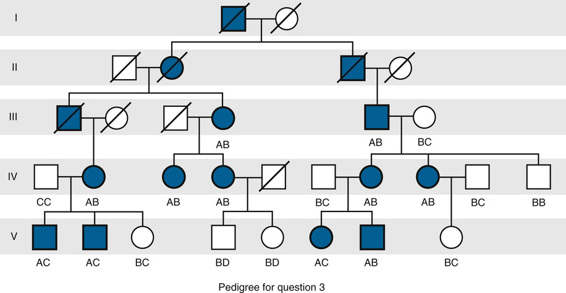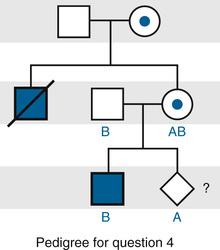How would you interpret these data? Why is the value of Z given as −∞ at θ = 0?
In a subsequent study, a large family from Sicily with what looks like the same disease was also investigated for linkage to α-globin, with the following results:

How would you interpret the data in this second study?
3. This pedigree was obtained in a study designed to determine whether a mutation in a gene for γ-crystallin, one of the major proteins of the eye lens, may be responsible for an autosomal dominant form of cataract. The filled-in symbols in the pedigree indicate family members with cataracts. The letters indicate three alleles at the polymorphic γ-crystallin locus on chromosome 2. If you examine each affected person who has passed on the cataract to his or her children, how many of these represent a meiosis that is informative for linkage between the cataract and γ-crystallin? In which individuals is the phase known between the cataract mutation and the γ-crystallin alleles? Are there any meioses in which a crossover must have occurred to explain the data? What would you conclude about linkage between the cataract and γ-crystallin from this study? What additional studies might be performed to confirm or reject the hypothesis?

4. The following pedigree shows an example of molecular diagnosis in Wiskott-Aldrich syndrome, an X-linked immunodeficiency, by use of a linked DNA polymorphism with a map distance of approximately 5 cM between the polymorphic locus and the Wiskott-Aldrich syndrome gene.
a. What is the likely phase in the carrier mother? How did you determine this? What diagnosis would you make regarding the current prenatal diagnosis if it were a male fetus?
b. The maternal grandfather now becomes available for DNA testing and shows allele B at the linked locus. How does this finding affect your determination of phase in the mother? What diagnosis would you make now in regard to the current prenatal diagnosis?





